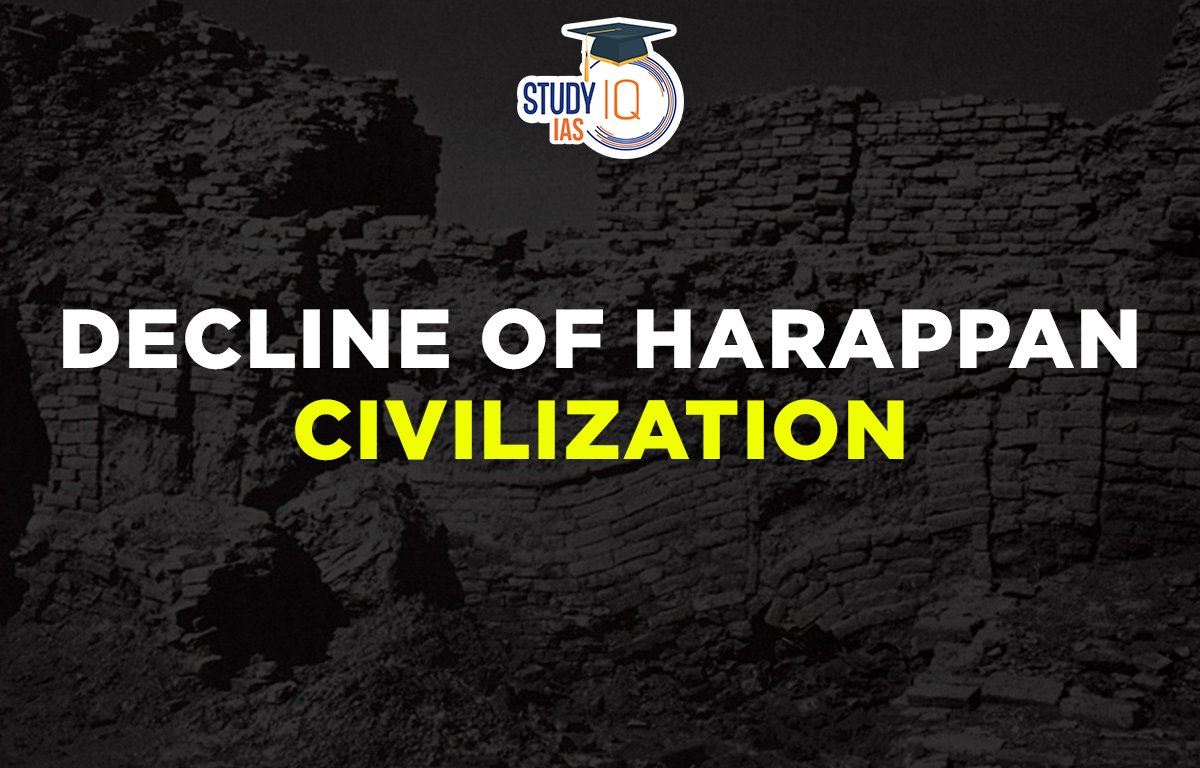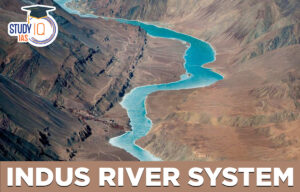Table of Contents
Decline of Harappan Civilization
From 3300 to 1300 BCE, the Harappan Civilization—also called the Indus River Valley Civilization—ran across what is now northeast Afghanistan, Pakistan, and northwest India. There is debate among scholars regarding the factors that led to the Indus Valley Civilization collapse around 1800 BCE. According to one theory, a nomadic Indo-European group known as the Aryans invaded and subjugated the Harappan Civilization. You can use this piece to learn about the decline of the Harappan civilization as you study ancient history for the UPSC Civil Service Exam. It is an integral part of the history of UPSC Syllabus.
Read about: South Indian Dynasties
Decline of Indus Valley Civilisation History
There is proof that most Mature Harappan sites in regions like Cholistan had been abandoned by 1800 BCE. In Gujarat, Haryana, and western Uttar Pradesh, there was a rise in population into new settlements at the same time. Many academics think that the Decline of Harappan Civilization was caused by environmental change.
Some academics contend that the region’s climate changed primarily as a result of the Saraswati River drying out around 1900 BCE, while others contend that a significant inundation occurred at the time. The Indus Civilization’s various components have been found in later societies, showing that an invasion did not cause its abrupt demise. According to many researchers, the large civilization’s dissolution into smaller communities known as the late Harappan civilizations was triggered by changes in river patterns.
Read about: Sangam Literature
Decline of Harappan Civilisation Causes
Many explanations have been put forth. Examples include misuse of the terrain, climate change, deforestation, severe flooding, waterway shifting or drying up, and extreme weather conditions. These “causes” might be accurate for some localities, but they do not explain the demise of the complete civilization. Another disastrous change to the Harappan climate might have been caused by winds that blow eastward and generate heavy rain.
Depending on whether they preserve or annihilate flora and crops, monsoons can either be helpful or detrimental to a climate. The Indus Valley had become colder and drier by 1800 BCE, and the river networks that supported the Indus Valley Civilization may have been disrupted or rerouted as a result of a seismic event. The Ganges basin is where the Harappans may have moved, where they may have founded villages and solitary farms.
The same agricultural surpluses needed by large communities could not have been produced in these small towns. Due to lower product production, trade with Egypt and Mesopotamia would have suffered. The majority of the cities of the Indus Valley Civilization had been abandoned by around 1700 BCE.
Read about: Later Vedic Period
Decline of Harappan Civilization Associated Theories
Depending on whether they preserve or annihilate flora and crops, monsoons can either be helpful or detrimental to a climate. The Indus Valley had become colder and drier by 1800 BCE, and the river networks that supported the Indus Valley Civilization may have been disrupted or rerouted as a result of a seismic event. The Ganges basin is where the Harappans may have moved, where they may have founded villages and solitary farms.
The same agricultural surpluses needed by large communities could not have been produced in these small towns. Due to lower product production, trade with Egypt and Mesopotamia would have suffered. The majority of the cities of the Indus Valley Civilization had been abandoned by around 1700 BCE.
Read about: Rig Vedic Period
Decline of Harappan Civilisation Aryan Invasion
The idea that the civilization was extinguished by Aryan invaders was first put forth by Ramaprasad Chanda, but he subsequently changed his mind and Mortimer Wheeler developed it. Wheeler believed that the Harappan civilization was completely destroyed by the Aryan incursion. As proof of the Aryan massacre, Wheeler pointed to human skeletons found at Mohenjodaro during the final phases of occupancy.
Wheeler argued that references to different kinds of forts, assaults on fortified towns, and the epithet purandara (fort destroyer) of the god Indra all lead to an Aryan invasion of the Harappan cities. Punjab and the Ghaggar-Hakra territory were home to the Rig Vedic Aryans. Given that no other cultural groups had forts in this region during this time in history, Wheeler believed that the Harappan towns were being mentioned in the Rig Veda.
Read about: Sangam Period
Decline of Harappan Civilisation and Natural Disasters
Even though they are not always instant or singular, natural disasters can play a part. Numerous Indus towns, such as Mohenjodaro, Chanhudaro, and Lothal, have silt debris from periods of settlement in between, emphasising the possibility of destruction brought on by swollen rivers. At Mohenjodaro, several strata of silt demonstrate that the city was affected by a series of Indus floods, which caused the Harappan civilization to disintegrate.
Different periods of habitation in Mohenjodaro appear to have been separated by evidence of major flooding. This is indicated by the repeated accumulation of crumbled building materials and silty clay on Mohenjodaro’s homes and streets. This silty mud appears to have been left behind by the floodwaters that had flooded the streets and homes. After the floods receded, the inhabitants of Mohenjodaro rebuilt homes and streets atop the remains of the previous buildings.
It appears that at least three instances of this catastrophic flooding and following reconstruction have taken place. Following M. R. Sahni, George F. Dales and Robert L. Raikes proposed that human mistakes may have contributed to the Mohenjodaro floods. The cause was due to tectonic changes. One theory holds that the Indus region is seismically active, and tectonic movements caused a massive natural barrier to develop that prevented the Indus from flowing towards the sea. Making a large lagoon out of the area around Mohenjodaro.
Read about: Gupta Empire
Decline of Harappan Civilisation and Ecological Imbalance
Environmental concerns have been used as an explanation for the decline of the Harappan society by academics like Fairservis. Using current data to estimate population, land, food, and fodder requirements, Fairservis hypothesises that the Harappan cultural zone’s resources could not support the growing population and cattle.
Therefore, the fragile ecological balance of these semi-arid regions was being upset as a result of human and cattle populations in these areas quickly depleting the few trees, food, and fuel sources. Harappan over-exploitation of the environment included excessive tree cutting for farming and fuel as well as over-cultivation, over-grazing, and over-grazing.
Harappan townspeople, farmers, and pastoralists had more needs than these communities’ meagre production capability could handle. As a consequence, an expanding human and animal population struggling with scarce resources wore down the landscape. As a consequence, forests and grasslands would have gradually disappeared, and there would also have been an increase in flooding, droughts, and soil salinity.
1. Moving away from Indus
According to Lambrick, changes in the Indus River’s course may have contributed to the collapse of the Indus Valley civilization. The Indus is a network of waterways with an unstable bed. The Indus River reportedly shifted thirty kilometres away from Mohenjodaro. Due to a lack of water, residents of the city and the surrounding agrarian villages moved away.
This happened several times during Mohenjodaro’s life. The wind has brought a lot of sand and silt into the metropolis, which has caused the silt that can be seen there. Due to the combination of this silt with buildings made of crumbling mud, mud brick, and baked brick, it was mistaken for river silt.
2. Climatic Change
While natural floods may have worn down Mohenjodaro, Harappan sites in the Ghaggar-Hakra region experienced progressive desiccation. D.P. Agarwal and Sood assert that the Harappan civilization was destroyed when the Ghaggar-Hakra waterway dried up and the area became more arid. They found that the amount of dry weather had grown by the middle of the second millennium B.C. In semi-arid regions like the Harappa, even a small reduction in moisture and water supply could have catastrophic effects. It would affect agricultural output, straining the economies of cities.
Read about: Mauryan Empire
Decline of Harappan Civilization UPSC
Many experts think that climatic change was to blame for the fall of the Indus Valley Civilization. Most Harappan towns had been nearly totally abandoned by 1800 BCE. The communities in the foothills eventually declined as well. Some scholars believe that the drying of the Saraswati River, which began approximately 1900 BCE, was the primary cause of climatic change, while others believe that a large flood hit the area. To know more about Harappan Civilization candidates must visit the official website of StudyIQ UPSC Online Coaching for UPSC Exam preparations.
Read about: Rashtrakuta Dynasty


 Indus River System, Tributaries, and Sin...
Indus River System, Tributaries, and Sin...
 Jallianwala Bagh Massacre, Date, History...
Jallianwala Bagh Massacre, Date, History...
 Important Lakes of India, State wise and...
Important Lakes of India, State wise and...





















